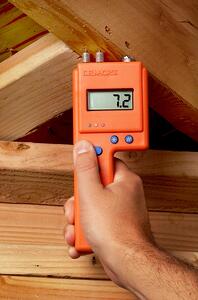Pin meters are the most commonly used moisture measuring devices on the market. They are a surefire way to obtain three key pieces of information quickly and accurately, including:
-
moisture gradient (the difference between the shell and core moisture).
-
an estimate of the average moisture content.
-
the range of moisture content.
 Pin-type meters operate on the principle of electrical resistance; they use the wood as an element in a circuit by driving two pins or electrodes into it.
Pin-type meters operate on the principle of electrical resistance; they use the wood as an element in a circuit by driving two pins or electrodes into it.
The theory of electrical resistance is credited to George Ohm, who established a theory of how electricity works all the way back in 1827, when he published a book on the subject. Because of Ohm's part in establishing the theoretical operation of electricity and the formulas for measuring the resistance of electrical current in objects, the measurement of electrical resistance is called the ohm in his honor.
The electrical resistance method for determining moisture content had been around for years, but became fully accepted by the industry in the late 1940’s, when Delmhorst introduced its ram-type electrode with two insulated pins.
The pins in a pin meter operate as electrodes: one generates an electrical current, and the other records how much resistance there is to the electrical current, which is measured in ohms.
To put it simply, the higher the electrical resistance is in a piece of wood, the less moisture there is in that piece of wood.
This is known as a resistance measurement. This method works because moisture is an excellent conductor of electricity and dry wood is an effective insulator. Pin Meters are highly accurate when used in wood, gypsum, insulation, or concrete.
However, keep in mind that you may have to calibrate your meter in order to get an accurate reading because different materials will not react the same way to electricity, even if they seem to have similar properties. For example, two different species of wood, such as Douglas Fir and Oak, will not produce the same results when measured because of differences in the inherent chemical content and conductivity of the two types of wood.
The most important feature of resistance type meters with insulated pins is that they measure only at the depth pins have been driven and in a line between the non-insulated portion of the pins. So, the user can drive pins into the wood in as little as l/8” increments to read the moisture content (M.C.) at different depths, leaving no question as to actual moisture content, distribution, and range.
The advantages to using a pin meter include:
-
Precise and accurate readings on wood, gypsum, insulation, and concrete.
-
Surface texture does not affect readings so long as the pins can penetrate the material.
-
A maximum measuring depth of approximately 2”, depending on length of contact pins.
-
Measurements are available instantly.
The disadvantages of pin moisture meters include:
-
They leave two small holes in the surface of the object.
-
Material temperature can distort readings.
-
Moisture pockets can give abnormally high readings not in line with overall moisture of the object (although, if you are taking several measurements in a single object, this can be an advantage, as it helps you locate the depth at which such moisture pockets are occurring).
The speed and ease with which a pin meter can give a contractor a reliable reading of moisture content in a given piece of wood may be one of the key reasons why they were adopted for use by contractors around the world.
Considering their reliability and ease of use, it is little surprise that pin meters have been a staple of moisture measurement for so many decades. If you are looking for an accurate, reliable moisture meter, then a pin-type meter may be the perfect tool for your needs.
To learn more about moisture meters, contact us today.

Comments